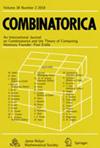适当边缘着色图形中的彩虹循环
IF 1
2区 数学
Q1 MATHEMATICS
引用次数: 0
摘要
我们证明了平均阶数至少为 \(32(\log 5n)^2\) 的每个适当边缘着色的 n 顶点图都包含一个彩虹循环,这改进了 Tomon 提出的 \((\log n)^{2+o(1)}\) 约束。我们还证明了每一个具有至少 \(10^5 k^3 n^{1+1/k}\) 条边的适当边着色 n 顶点图都包含一个彩虹 2k 循环,这改进了 Janzer 之前得到的约束 \(2^{ck^2}n^{1+1/k}\)。我们使用同态不等式和片面正则化公设的方法还为证明偶数循环的厄尔多斯-西蒙诺维茨超饱和定理提供了一种简单的方法,这可能是一个独立的兴趣点。本文章由计算机程序翻译,如有差异,请以英文原文为准。
Rainbow Cycles in Properly Edge-Colored Graphs
We prove that every properly edge-colored n-vertex graph with average degree at least \(32(\log 5n)^2\) contains a rainbow cycle, improving upon the \((\log n)^{2+o(1)}\) bound due to Tomon. We also prove that every properly edge-colored n-vertex graph with at least \(10^5 k^3 n^{1+1/k}\) edges contains a rainbow 2k-cycle, which improves the previous bound \(2^{ck^2}n^{1+1/k}\) obtained by Janzer. Our method using homomorphism inequalities and a lopsided regularization lemma also provides a simple way to prove the Erdős–Simonovits supersaturation theorem for even cycles, which may be of independent interest.
求助全文
通过发布文献求助,成功后即可免费获取论文全文。
去求助
来源期刊

Combinatorica
数学-数学
CiteScore
1.90
自引率
0.00%
发文量
45
审稿时长
>12 weeks
期刊介绍:
COMBINATORICA publishes research papers in English in a variety of areas of combinatorics and the theory of computing, with particular emphasis on general techniques and unifying principles. Typical but not exclusive topics covered by COMBINATORICA are
- Combinatorial structures (graphs, hypergraphs, matroids, designs, permutation groups).
- Combinatorial optimization.
- Combinatorial aspects of geometry and number theory.
- Algorithms in combinatorics and related fields.
- Computational complexity theory.
- Randomization and explicit construction in combinatorics and algorithms.
 求助内容:
求助内容: 应助结果提醒方式:
应助结果提醒方式:


